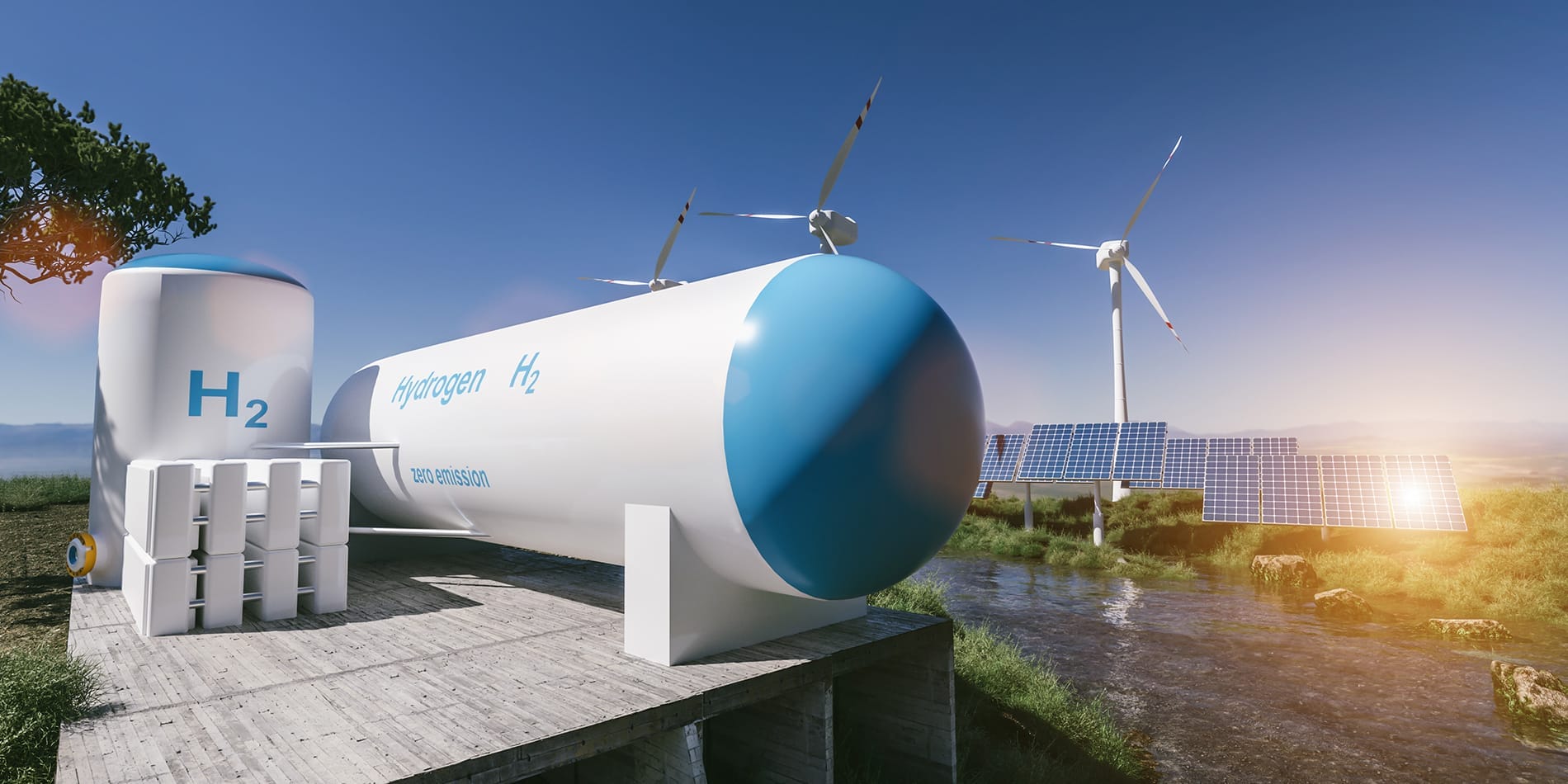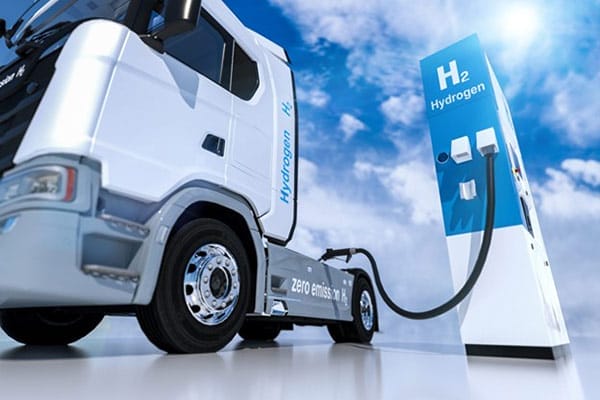Key Takeaways
- Hydrogen isn’t burned like fossil fuels; instead, it’s combined with oxygen to create water, which results in a small electrical charge that powers a motor.
- Hydrogen production is an energy-hungry process, making adaptation of renewable energy a must to minimize its carbon footprint.
- Green hydrogen production costs remain high, but they are lowering as technology advances.
The concept of a hydrogen economy as a solution to our energy needs has garnered much interest recently. A hydrogen economy represents a shift from traditional fossil fuel energy systems toward a cleaner, more sustainable, and renewable energy future.
But what exactly is the hydrogen economy, and how does it differ from the energy systems we already know? Get the answers to these questions and much more as we delve into the emergence of this growing field.
What Is the Hydrogen Economy? How Does It Differ From Traditional Energy Systems?
The hydrogen economy is a system that uses hydrogen gas as a primary energy source. While traditional energy systems rely heavily on fossil fuels, the hydrogen economy promotes the use of hydrogen as a versatile, clean, and renewable energy carrier.
Traditional energy systems rely on carbon-based fuel combustion, releasing greenhouse gas (GHG) emissions into the atmosphere. The hydrogen economy, on the other hand, is a pathway toward a carbon-neutral energy system. This is because hydrogen can be produced from various renewable sources and produces no harmful emissions when used as a fuel.
Another significant difference is the hydrogen economy’s potential to revolutionize various sectors, including transportation, industry, and residential energy use. For example, hydrogen fuel cell vehicles offer a zero-emission alternative to traditional gasoline and diesel vehicles, providing a cleaner transportation option for the future.
In industry, hydrogen can be a feedstock for chemical processes, reducing reliance on fossil fuels and lowering overall carbon emissions.
In residential applications, hydrogen fuel cells can deliver efficient and eco-friendly power generation for homes, contributing to more sustainable living.
As much of the world aims to transition to green energy sources, the hydrogen economy is a promising solution for a greener and more sustainable future.
What Are the Various Hydrogen Production Methods?
Hydrogen can be produced through various methods, each with its own environmental and economic considerations. The three main production methods are green, blue, and gray.
Green Hydrogen Production
One method is green hydrogen production. This process uses renewable energy sources, such as wind or solar power, to electrolyze water and separate hydrogen from oxygen. It is the most environmentally friendly, as it produces zero emissions.
Green hydrogen is becoming more popular worldwide as countries aim to reduce GHG emissions and transition to a cleaner energy future. The process behind green hydrogen is electrolysis, an electrochemical process that breaks down a compound using an electric current. The biggest hurdle is that electrolysis requires significant energy and a renewable energy infrastructure to support it. Fortunately, advancements in technology are making it more efficient and cost-effective.
Enter your ZIP Code and compare electricity rates
Blue Hydrogen Production
Another method is blue hydrogen production. This method captures and stores the carbon emissions from non-green hydrogen production, resulting in low-carbon hydrogen. Using carbon capture and storage (CCS) technology, this process mitigates some of the negative environmental effects of hydrogen production.
Blue hydrogen production uses steam reforming to merge natural gas and heated water in steam form. The chemical reaction outputs hydrogen and carbon dioxide (CO2). Using the previously mentioned CCS, the process also captures most of the CO2 emissions.
Blue hydrogen is a transitional solution toward a fully decarbonized hydrogen economy. It can provide a bridge between conventional fossil fuel-based energy and cleaner alternatives. Implementing CCS technology at a large scale is a significant challenge for the broader adoption of blue hydrogen.
Gray Hydrogen Production
Currently, gray hydrogen production is the most common method. It also uses steam reforming, combining natural gas or methane with steam to form hydrogen. Where gray hydrogen differs from blue hydrogen is its lack of a CCS. This allows CO2 to reach the atmosphere unmitigated, meaning it has a significantly higher carbon footprint than all other hydrogen production methods.
While green hydrogen is the most sustainable option, hydrogen production scalability and cost-effectiveness are still areas of research and development. Balancing economic viability and environmental impact will be crucial in determining the most viable hydrogen production methods.
How Can Hydrogen Be Stored and Transported Efficiently to Meet Energy Demands?
Hydrogen has the highest energy potential per mass among all fuels, but its low ambient temperature density leaves it short on energy in terms of volume. As such, storing and transporting hydrogen supplies presents significant challenges.
The hydrogen industry has explored various storage methods, such as compressed hydrogen gas, cryogenic compressed hydrogen, and liquid hydrogen. Additionally, technical advancements have led to solid-state hydrogen storage developments, which result in higher energy densities and improved safety compared to conventional storage methods.
Hydrogen transportation can be through pipelines, similar to natural gas, or in specialized high-pressure containers for longer distances. Delivering a useful amount of hydrogen is impacted by its low density, so hydrogen transporters often have to put it under extremely high pressure or liquefy it to increase the mass it can carry. With this comes highly specialized equipment and tanks.
Establishing a robust hydrogen infrastructure is vital in meeting energy demands with hydrogen gas and promoting its widespread adoption as an alternative fuel.
How Does Hydrogen Help Decarbonize Industries?
In transportation, hydrogen fuel cell (HFC) vehicles are a clean alternative to internal combustion engines. They combine oxygen and hydrogen, which creates a small electrical charge that helps fuel a battery pack that powers an electric motor.
And what byproduct do you get when you combine hydrogen and oxygen? Water. This means the only emissions HFC vehicles have is water vapor.
Hydrogen can fuel many automobiles, from small company cars to heavy-duty vehicles, such as trucks and buses. This is particularly helpful in areas where relying on battery power alone isn’t feasible, such as in long-haul trucking and the shipping industry.
In manufacturing, hydrogen can be a clean and efficient fuel for industrial processes, helping reduce fossil fuel dependence and minimizing carbon emissions.
Hydrogen can also help in the energy production sector. It can complement renewable energy sources, such as solar and wind power, through energy storage and power generation. This is especially helpful when renewable energy production is low, such as after the sun sets, on a cloudy day, or a day with little wind. In turn, when renewable energy production is high, the excess renewable energy can help power electrolysis to create more hydrogen in a green manner.
What Environmental Benefits and Challenges Come With Using Hydrogen for Clean Energy?
Using hydrogen as a clean energy source comes with plenty of environmental benefits.
First, when renewable energy powers hydrogen production, there are no greenhouse gas emissions when creating or using hydrogen as fuel. This makes integrating renewable energy in hydrogen production a key player in mitigating carbon emissions and climate change. Second, hydrogen-powered fuel cells have twice the energy conversion efficiency of traditional combustion engines, enhancing overall energy efficiency.
Another significant advantage of the hydrogen economy is its potential to reduce GHG emissions and combat climate change. By using hydrogen as a clean energy carrier, individuals, organizations, and even entire countries can significantly reduce their carbon footprint and move towards a more sustainable future.
As mentioned, hydrogen can also play a role in supporting renewable electricity sources, such as wind and solar power, through energy storage. One issue with these alternative energy sources is they can produce excess power when the winds are blowing and the sun shines brightly. However, when the wind stops and the sun sets, they produce little to no energy. Hydrogen can address this issue through energy storage and distribution when alternative sources can no longer produce energy, building a bridge toward a more reliable and resilient renewable energy system.
Widespread adoption of hydrogen as a clean energy source also poses challenges. For instance, the production of hydrogen on a large scale comes with substantial energy consumption. Unfortunately, much of this energy may come from non-renewable power plants, dramatically increasing its carbon footprint. To maximize hydrogen’s environmental benefits, the industry needs a renewable energy transition for the future of hydrogen production.
What Economic Considerations and Challenges Impact the Scaling Hydrogen Production and Infrastructure?
Scaling up hydrogen production and infrastructure to meet the world’s clean energy needs has its fair share of economic considerations and challenges. Let’s review what’s standing in the way right now.
First, green hydrogen production cost is high at about $3 to $6 per kilogram. However, with technological advancements, the cost of hydrogen production may decrease over time, making it more economically viable.
The other consideration is the infrastructure. Hydrogen suppliers and other stakeholders must establish an extensive network of hydrogen production facilities, storage facilities, transportation networks, and refueling stations. This will likely require significant investment. In addition, they must ensure interoperability and standardization to streamline widespread hydrogen use.
Addressing these economic considerations and challenges will require collaboration among industry stakeholders, policymakers, and investors.
What Ongoing Research and Innovations Are Shaping the Hydrogen Economy’s Future?
Ongoing research and innovations will be crucial in shaping the hydrogen market’s future. Scientists and engineers are exploring new clean hydrogen production methods that are more efficient and eco-friendly. This includes advancements in catalyst technology and electrolysis processes to increase green hydrogen production’s viability.
Researchers are also developing new hydrogen technology, such as fatigue-resistant membranes, to increase fuel cell efficiency and durability. They are also working on reducing costs by switching to smaller stacks and developing more streamlined cell designs to bolster fuel cell technology’s viability in the commercial space.
The hydrogen economy’s future lies in ongoing research, collaboration, and innovation to tackle the challenges and harness hydrogen energy’s full potential as a clean energy source to enhance sustainability in America and worldwide.
The Hydrogen Economy Offers the Potential for a Greener Future
The hydrogen economy presents an exciting opportunity for the world to transition into a cleaner, more sustainable energy system. With advancements in certain areas, hydrogen can play an important part in decarbonizing industries and reducing GHG emissions.
Economic considerations and challenges associated with scaling up hydrogen production and infrastructure exist, but ongoing research and innovations are shaping the hydrogen economy’s future. An effective hydrogen strategy will include improvements in hydrogen production efficiency, fuel cell technology, and hydrogen storage. These advancements will help pave the way for a more sustainable and carbon-neutral future.
Brought to you by energysavings.com
All images licensed from Adobe Stock.




